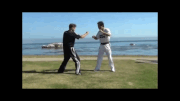I think a lot of posters are probably saying the same thing, but from different view points, and based on their own experiences.
Things like going unconscious and making noise, versus not making noise. If you are knowledgeable about air chokes versus blood chokes, with an air choke taking much longer to incapacitate a person than a proper blood choke. In an airway choke, you are restricting the air supply (obviously), and it takes awhile to go completely out. Gasping, grunting, or making noises is common. However, a proper blood choke puts a person out quickly, and odds are you are not going to hear them make noises.
Now lets take that same concept of being unconscious, and look at it from the POV of a fighter who kicks or strikes a person in the head, resulting in an unconscious opponent. You don't hear noises, gasps, or grunts in those cases as the brain is too busy slamming against the wall of the skull. If you have ever seen a fight in the street, dojo, or UFC where someone goes stiff when hit and they are still locked up on the ground, that is a knock out.
When we bring the above into the realm of "pressure points" or nerve strikes, we have to consider the same things, mainly there are various ways to impact a nerve cluster, and there are a lot of ways for a opponent to be facing or countering.
One poster talks about compliance rapidly gained in hospital settings via pressure point and head control. That is fantastic, because that pain comes on ultra quick, but vanishes very quickly as well. I can tell you from personal experience that when you palm strike a "patient" in ER (and send him flipping over the table) that the attending doctors tend to get exceedingly worked up. The doctors live in nice places, in bubbles, and ignore why the suspect/ patient is in the ER to begin with.
For anyone who says nerve stuff and pressure points don't work against them is incorrect, but only because they are looking at things from certain perspectives. Let us consider the entirety of the nervous system. I think most of us will agree the testicles are rather sensitive. Sure there are guys who say they can take a hit to the junk, but it doesn't typically work out that way. The eyes tend to be rather sensitive as well. Not every pressure point is located in the inside of the upper arm, or the liver. Not every nerve cluster is a magic hidden spot.
What we do need to remember is that when we are in a legitimate real world fight, pressure points are not TYPICALLY the best of targets. I say this based on my own training and experience. When things get really bad, breaking down the skeletal structure is a quick way to terminate events. Arms and legs being broken ends fights quickly. Breaking shoulders does as well. We train in our various disciplines, but we need to consider a larger picture. If we have no ground fighting ability, we will probably lose to a BJJ or wrestling opponent. We all like to believe, or want to believe that it can't happen, but it can, and it does. If you only do standup, you need to get a ground game going.
Pressure points and nerve clusters are legit, but they are not magic. Much like a punch that is blocked or misses, not everything work all the time.
Hopefully the above makes a little bit of sense. I tried to condense it, but am happy to expand on any of it.
Regard to all....
Stick


